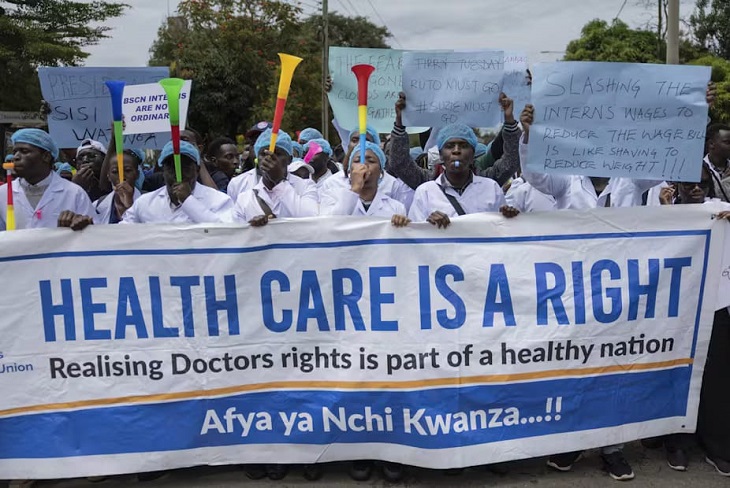Kenya’s healthcare system is standing on shaky ground. While policymakers envision progress, the foundation remains dangerously underbuilt, particularly when it comes to handling emergencies and delivering critical services.
A stark illustration of this is found in the 2023 Health Facilities Census, which reveals that a mere 5.8% of facilities have functioning accident and emergency units. Less than half provide maternity services.
In rural areas, ambulances are scarce, oxygen is a luxury, and blood transfusion services remain inaccessible for many.
These grim realities are not new. Chronic underfunding, both at the national and county levels, has long choked the lifeblood out of public healthcare delivery. While private and faith-based institutions strive to fill the gap, they cannot overcome systemic failures on their own.
In this fragile ecosystem, the introduction of the Quality Healthcare and Patient Safety Bill, 2025, raises serious concerns. While its goal, to improve care quality and patient accountability, is commendable, its provisions may unintentionally stifle the very institutions it hopes to regulate and uplift.
The Bill proposes a new regulatory Authority for health facilities, yet Kenya already has multiple statutory bodies overseeing different aspects of medical practice and facility regulation: the Kenya Medical Practitioners and Dentists Council (KMPDC), the Nursing Council, the Pharmacy and Poisons Board, and the Medical Laboratory Technicians and Technologists Board.
Overlaying another regulatory body onto this already dense framework risks deepening fragmentation, encouraging turf wars, and creating policy paralysis.
Moreover, the Bill mandates compliance with certified digital health systems managed by a newly created Digital Health Agency (DHA). While digitization is essential in modern healthcare, the devil lies in the details.
The DHA’s mandate remains vague, and its potential costs—both in licensing and software implementation- are unknown. Yet, facilities will be compelled to adopt their systems as a precondition for licensing.
The compliance burden is particularly worrying for smaller, often rural, health facilities that already operate on razor-thin margins. These facilities are lifelines for millions of Kenyans. The proposed multiple layers of bureaucracy, pre-licensing inspections, digital certifications, accreditations, and performance ratings could lead to operational delays and drive up costs without demonstrably improving patient outcomes.
Instead of empowering healthcare providers, the Bill risks driving them into “defensive medicine”, a costly and cautious practice driven by fear of litigation and fines. It doesn’t help that the Bill imposes hefty penalties of up to Sh50 million or 10-year prison terms, even for administrative lapses. This punitive approach is more likely to push facilities into closure or deter new entrants altogether than to enhance patient safety.
Kenya’s quest for Universal Health Coverage (UHC) hinges on expanding, not restricting, access to quality, affordable healthcare. By layering regulatory demands, escalating compliance costs, and threatening punitive action, this Bill may discourage private investment in healthcare, particularly in underserved areas where public sector facilities are already overstretched.
Instead of addressing critical bottlenecks, such as staff shortages, lack of diagnostic tools, poor enforcement of existing regulations, and inadequate funding, this Bill seeks to paper over cracks with a complex, compliance-heavy framework. In doing so, it may create more obstacles than solutions.
Rather than rushing punitive legislation through Parliament, Kenya needs a more measured, consultative approach to health reform. Any serious effort to improve quality and safety must begin with strengthening the fundamentals:
-
Adequate funding of health infrastructure and staffing
-
Improved enforcement of existing regulations
-
Equitable resource allocation, particularly to rural and marginalized regions
-
A clear and consolidated regulatory structure that eliminates duplication and conflict
What the country needs is not more laws, but better systems, systems that are designed with the realities of both urban and rural healthcare provision in mind. Before passing this Bill, there must be a national conversation involving all stakeholders, health professionals, private sector players, county governments, and patient advocacy groups.
The dream of high-quality, safe healthcare for every Kenyan is noble. But dreams must be anchored in reality. If not carefully reviewed and restructured, the Quality Healthcare and Patient Safety Bill, 2025, could end up doing more harm than good—raising barriers to access, pushing providers to the brink, and stalling our journey to UHC.
Sometimes, doing less can achieve more, especially when what’s truly needed is strategic focus and bold investment, not bureaucracy wrapped in legislation.
Related Content: Here Is Why Every Kenyan Needs Health Insurance













